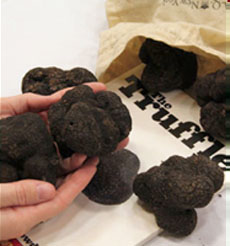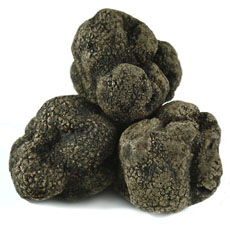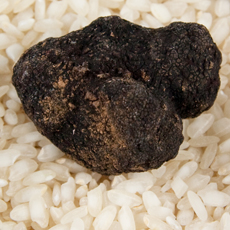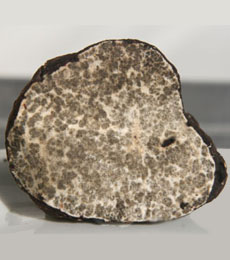
 Affordable, but without the intense flavor and aroma of the “king of truffles.” Photo courtesy Truffle-Tree.com.
Affordable, but without the intense flavor and aroma of the “king of truffles.” Photo courtesy Truffle-Tree.com.
|
|
|
KAREN HOCHMAN is Editorial Director of THE NIBBLE.
|
|
December 2006
Last Updated January 2016
|
 |
Black Truffle Types, Continued
Page 7: Chinese & Oregon Black Truffles
This is Page 7 of a 12-page article. Click on the black links below to visit other pages.
Truffle Glossary: Other Black Truffles
CHINESE BLACK TRUFFLE
|
Chinese black truffles include Tuber sinensis/a.k.a. Tuber himalayensis and Tuber indicum. Tuber sinensis looks exactly like Tuber melanosporum, the Périgord truffle, and it is said that even experts and would require a microscope to differentiate between the two truffle. The similarity ends there, though: the aroma and glebe (the inside) have nothing in common. They are cheap, rubbery truffles, selling for $20 pound/wholesale in China, compared to $800/pound/wholesale for Périgord. That gives them no more value in flavor and texture than a wild mushroom. They are most often used in the West when the appearance of “truffle” is desired, e.g. in pate de foie gras and as a garnish for hors d’oeuvre.
|
|

Chinese black truffle. Photo courtesy Earthy.com. |
in fact, prior to its import to the West in the last decade or so, there is no record of culinary use in China, where they are used medicinally. In the West, truffle fraud is rampant: Allowed to rest with authentic Périgord truffles, they will take on their aroma, and can be sold to unwitting buyers for the same sky-high prices. They are imported and deliberately doctored, through the transfer of aroma and sometimes artificial coloring, to pass as Tuber melanosporum, the Périgord truffles. This is why you should only buy truffles from trusted purveyors, and read labels of foods that include truffles carefully. The fact that a product is manufactured in France does not mean that the truffles are Périgord black truffles. They can be made from imported Chinese truffles. That being said, if you find them priced like wild mushrooms and want a wild mushroom accent to your dish, go for it!
OREGON BLACK TRUFFLE
Both black truffles (Leucangium carthusiana) and white truffles ( Tuber oregonense and Tuber gibbosum,* formerly known as Tuber gigantum) are found in the Pacific Northwest, from Vancouver Island, British Columbia, to northern California. Oregon has a large concentration of them, often found in the Douglas Fir forests of the Willamette Valley. The season is November through March. The black truffle has a dark brown exterior and a white glebe when unripe; it matures to a dark brown glebe with white veins (here’s information on Oregon white truffles). They have a pungent, earthy truffle aroma with notes of pineapple, and a strong truffle flavor that has made them popular with chefs in the region. They can be used in everything from hearty, meat-based dishes to delicate desserts. As with some other truffles, the aroma of Oregon truffles dissipates with heat, so they must be treated with the same care as Italian white truffles—shaved raw over food, never cooked. The black truffles have
*These are actually the same species; Oregonense fruits in the winter, gibbosum fruits in the spring.
SPANISH BLACK TRUFFLE
In the hills of east-central Spain, Tuber melanosporum vitt., commonly known as the Périgord truffle, is being grown successfully for export (95% is exported, and some of it is incorrectly labeled as Périgord truffles, although the quality is said to be at least as good). Climate change has decimated the Perigord truffle crop to 56 metric tons in 2014, compared with a peak of 1,040 tons 100 years earlier, in 1904. In 2014, Spain produced 45 tons of truffles (source). While the truffles grow wild here, the crop is abetted by the method, developed in France, where spores of Tuber melanosporum are injected into the root of a sapling in a greenhouse setting, then transferred to a field. In three years, the tree starts producing a single truffle yearly; the number increases as the trees mature.
Continue To Page 8: Truffle Glossary ~
White Truffles
Go To The Article Index Above
|
|

Oregon black truffle. Photo courtesy TasteOfOregon.com.

The glebe (inside). Photo courtesy Xylos Truffle Oil.

These Oregon black truffles have a darker glebe. The color changes with maturity as well as seasonal growing conditions. Photo courtesy of PortlandFood.org.

Tuber melanosporum from Spain. Photo courtesy Foods From Spain.
|
Lifestyle Direct, Inc. All rights reserved. Images are the copyright of their respective owners.

|
|
|









